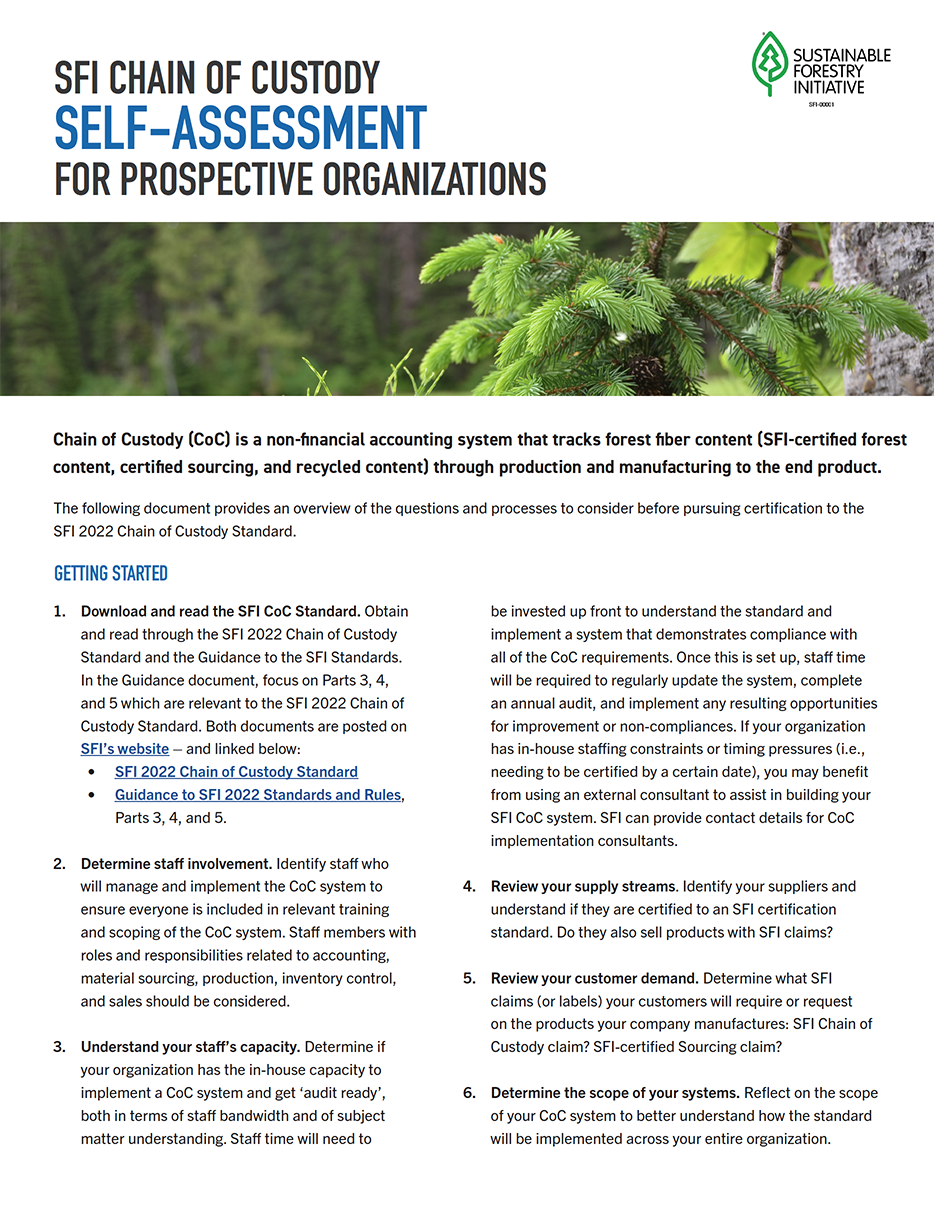SFI 2022 CHAIN-OF-CUSTODY STANDARD
is an accounting system that tracks forest fiber content (certified forest content, certified sourcing and recycled content) through production and manufacturing to the end product.

Companies can use chain-of-custody certification to track and communicate forest-fiber content using one of three optional approaches for chain of custody: physical separation, percentage, and the credit method (mixed inputs). To be certified, companies must be audited to the SFI 2022 Chain-of-Custody Standard (Section 4, SFI 2022 Standards and Rules).
The SFI Chain-of-Custody Standard applies to any organization that sources, processes, manufactures, handles, trades, converts or prints forest-based products. They must have processes such as inventory control, employee training, reporting, and invoicing so they can track raw materials from certified sources, certified sourcing and, when it applies, recycled content through production and manufacturing to the end product.
Consumers in growing numbers want assurance that their buying decisions represent a sound environmental choice. They are asking for proof that wood, paper, and packaging products are made with raw materials from certified forest content, certified sourcing or recycled content. SFI’s Chain-of-Custody Standard and associated labels deliver a reliable and credible mechanism so businesses can provide this assurance to customers.
All certification programs, including SFI, allow the following two methods to identify the percentage of certified fiber. Companies can also physically separate the certified forest content to make a 100% certified forest content claim.
The percentage method allows manufacturers to label 100% of their product with the SFI Certified Chain-of-Custody label. If an organization wishes to use the SFI chain-of-custody label or make a chain-of-custody claim on 100% of an organization’s product, the content must be at least 70% composed of certified forest content and/or recycled material. If recycled content is not used, then the label must state, “Promoting Sustainable Forestry.” If an organization does not meet that 70% threshold, it must transparently disclose the actual percentage of certified forest content or recycled material on the product label.
Under the credit method, an organization can only make claims or use the SFI label on the amount of certified input (certified forest content and recycled content) they have. So if the input of certified content is 30%, the organization can only make claims or use the SFI label on 30% of the output. This is consistent with all global chain-of-custody standards.
Conformance with the SFI Chain-of-Custody Standard is verified by an independent third-party certification audit. Whether it is paper, packaging or construction materials, a claim can be made regarding the certified content, similar to recycled content claims and labels seen on products.
The SFI 2022 Chain-of-Custody Standard has been assessed and recognized as a valid certification standard to make PEFC claims and apply to use the PEFC on-product logo. For more details, visit our Tools for PEFC Logo Users page.
SFI FOREST MANAGEMENT STANDARD
SFI FIBER SOURCING STANDARD
SFI ON DEFORESTATION/FOREST DEGRADATION
SFI CHAIN-OF-CUSTODY STANDARD
SFI CERTIFIED SOURCING STANDARD
SFI INDIGENOUS PEOPLES AND FAMILIES MODULE
SFI SMALL LANDS GROUP CERTIFICATION MODULE
SFI 2022 STANDARDS AND RULES (COMPLETE)
INTERPRETATIONS ON THE SFI 2022 STANDARDS AND RULES
SFI 2022 STANDARDS AND RULES REVISION PROCESS
CONFLICT TIMBER — RUSSIA AND BELARUS
Labels and Certification
Zachary Wagman
Senior Manager, Market Access
Tel: 613-745-3706
Standards
Gregor Macintosh
Senior Director, Standards
Tel: 778-351-3358
Program Participant Relations & SICs
Gordy Mouw
Director, Network Relations
Tel: 715-220-4132
Customer Affairs & Branding
Jason Metnick
Senior VP, Customer Affairs
Tel: 602-374-6539
Rachel Dierolf
Senior Director, Technical Operations & Reporting
Tel: 613-274-0124
FEATURED ARTICLE
NEW FOREST CERTIFICATION STANDARDS OFFERS NATURE-BASED SOLUTIONS TO THE CLIMATE CRISIS
The Sustainable Forestry Initiative’s (SFI) updated forest certification standards provide solutions to some of the world’s most pressing sustainability challenges. Sustainable forest management and the procurement of wood products from sustainably managed sources are critical tools that help avoid deforestation.



